+ Open data
Open data
- Basic information
Basic information
| Entry | Database: PDB / ID: 7o1v | ||||||
|---|---|---|---|---|---|---|---|
| Title | Structure of a Minimal Photosystem I | ||||||
 Components Components |
| ||||||
 Keywords Keywords | PHOTOSYNTHESIS / Photosystem I / excitation energy transfer / cyanobacteria / minimal structure | ||||||
| Function / homology |  Function and homology information Function and homology informationphotosystem I reaction center / photosystem I / photosynthetic electron transport in photosystem I / photosystem I / plasma membrane-derived thylakoid membrane / chlorophyll binding / photosynthesis / 4 iron, 4 sulfur cluster binding / oxidoreductase activity / electron transfer activity ...photosystem I reaction center / photosystem I / photosynthetic electron transport in photosystem I / photosystem I / plasma membrane-derived thylakoid membrane / chlorophyll binding / photosynthesis / 4 iron, 4 sulfur cluster binding / oxidoreductase activity / electron transfer activity / magnesium ion binding / metal ion binding / plasma membrane Similarity search - Function | ||||||
| Biological species |  | ||||||
| Method | ELECTRON MICROSCOPY / single particle reconstruction / cryo EM / Resolution: 4.31 Å | ||||||
 Authors Authors | Nelson, N. / Caspy, I. / Lambrev, P. | ||||||
| Funding support |  Israel, 1items Israel, 1items
| ||||||
 Citation Citation |  Journal: J Am Chem Soc / Year: 2021 Journal: J Am Chem Soc / Year: 2021Title: Two-Dimensional Electronic Spectroscopy of a Minimal Photosystem I Complex Reveals the Rate of Primary Charge Separation. Authors: Parveen Akhtar / Ido Caspy / Paweł J Nowakowski / Tirupathi Malavath / Nathan Nelson / Howe-Siang Tan / Petar H Lambrev /    Abstract: Photosystem I (PSI), found in all oxygenic photosynthetic organisms, uses solar energy to drive electron transport with nearly 100% quantum efficiency, thanks to fast energy transfer among antenna ...Photosystem I (PSI), found in all oxygenic photosynthetic organisms, uses solar energy to drive electron transport with nearly 100% quantum efficiency, thanks to fast energy transfer among antenna chlorophylls and charge separation in the reaction center. There is no complete consensus regarding the kinetics of the elementary steps involved in the overall trapping, especially the rate of primary charge separation. In this work, we employed two-dimensional coherent electronic spectroscopy to follow the dynamics of energy and electron transfer in a monomeric PSI complex from PCC 6803, containing only subunits A-E, K, and M, at 77 K. We also determined the structure of the complex to 4.3 Å resolution by cryoelectron microscopy with refinements to 2.5 Å. We applied structure-based modeling using a combined Redfield-Förster theory to compute the excitation dynamics. The absorptive 2D electronic spectra revealed fast excitonic/vibronic relaxation on time scales of 50-100 fs from the high-energy side of the absorption spectrum. Antenna excitations were funneled within 1 ps to a small pool of chlorophylls absorbing around 687 nm, thereafter decaying with 4-20 ps lifetimes, independently of excitation wavelength. Redfield-Förster energy transfer computations showed that the kinetics is limited by transfer from these red-shifted pigments. The rate of primary charge separation, upon direct excitation of the reaction center, was determined to be 1.2-1.5 ps. This result implies activationless electron transfer in PSI. | ||||||
| History |
|
- Structure visualization
Structure visualization
| Movie |
 Movie viewer Movie viewer |
|---|---|
| Structure viewer | Molecule:  Molmil Molmil Jmol/JSmol Jmol/JSmol |
- Downloads & links
Downloads & links
- Download
Download
| PDBx/mmCIF format |  7o1v.cif.gz 7o1v.cif.gz | 597.4 KB | Display |  PDBx/mmCIF format PDBx/mmCIF format |
|---|---|---|---|---|
| PDB format |  pdb7o1v.ent.gz pdb7o1v.ent.gz | 485.6 KB | Display |  PDB format PDB format |
| PDBx/mmJSON format |  7o1v.json.gz 7o1v.json.gz | Tree view |  PDBx/mmJSON format PDBx/mmJSON format | |
| Others |  Other downloads Other downloads |
-Validation report
| Summary document |  7o1v_validation.pdf.gz 7o1v_validation.pdf.gz | 7.6 MB | Display |  wwPDB validaton report wwPDB validaton report |
|---|---|---|---|---|
| Full document |  7o1v_full_validation.pdf.gz 7o1v_full_validation.pdf.gz | 8 MB | Display | |
| Data in XML |  7o1v_validation.xml.gz 7o1v_validation.xml.gz | 124.8 KB | Display | |
| Data in CIF |  7o1v_validation.cif.gz 7o1v_validation.cif.gz | 158.1 KB | Display | |
| Arichive directory |  https://data.pdbj.org/pub/pdb/validation_reports/o1/7o1v https://data.pdbj.org/pub/pdb/validation_reports/o1/7o1v ftp://data.pdbj.org/pub/pdb/validation_reports/o1/7o1v ftp://data.pdbj.org/pub/pdb/validation_reports/o1/7o1v | HTTPS FTP |
-Related structure data
| Related structure data |  12697MC M: map data used to model this data C: citing same article ( |
|---|---|
| Similar structure data |
- Links
Links
- Assembly
Assembly
| Deposited unit | 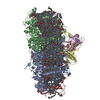
|
|---|---|
| 1 |
|
- Components
Components
-Photosystem I P700 chlorophyll a apoprotein ... , 2 types, 2 molecules AB
| #1: Protein | Mass: 81722.875 Da / Num. of mol.: 1 / Source method: isolated from a natural source Source: (natural)  Strain: PCC 6803 / Kazusa / References: UniProt: P29254, photosystem I |
|---|---|
| #2: Protein | Mass: 81167.258 Da / Num. of mol.: 1 / Source method: isolated from a natural source Source: (natural)  Strain: PCC 6803 / Kazusa / References: UniProt: P29255, photosystem I |
-Protein , 1 types, 1 molecules C
| #3: Protein | Mass: 8706.064 Da / Num. of mol.: 1 / Source method: isolated from a natural source Source: (natural)  Strain: PCC 6803 / Kazusa / References: UniProt: P32422, photosystem I |
|---|
-Photosystem I reaction center subunit ... , 4 types, 4 molecules DEKM
| #4: Protein | Mass: 15663.749 Da / Num. of mol.: 1 / Source method: isolated from a natural source Source: (natural)  Strain: PCC 6803 / Kazusa / References: UniProt: P19569 |
|---|---|
| #5: Protein | Mass: 7680.478 Da / Num. of mol.: 1 / Source method: isolated from a natural source Source: (natural)  Strain: PCC 6803 / Kazusa / References: UniProt: P12975 |
| #6: Protein | Mass: 8237.783 Da / Num. of mol.: 1 / Source method: isolated from a natural source Source: (natural)  Strain: PCC 6803 / Kazusa / References: UniProt: P74564 |
| #7: Protein/peptide | Mass: 3382.063 Da / Num. of mol.: 1 / Source method: isolated from a natural source Source: (natural)  Strain: PCC 6803 / Kazusa / References: UniProt: P72986 |
-Non-polymers , 8 types, 120 molecules 
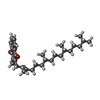













| #8: Chemical | ChemComp-CLA / #9: Chemical | #10: Chemical | ChemComp-BCR / #11: Chemical | ChemComp-LHG / #12: Chemical | ChemComp-LMG / #13: Chemical | #14: Chemical | #15: Chemical | ChemComp-SQD / | |
|---|
-Details
| Has ligand of interest | N |
|---|
-Experimental details
-Experiment
| Experiment | Method: ELECTRON MICROSCOPY |
|---|---|
| EM experiment | Aggregation state: PARTICLE / 3D reconstruction method: single particle reconstruction |
- Sample preparation
Sample preparation
| Component | Name: Minimal Photosystem I / Type: COMPLEX / Entity ID: #1-#7 / Source: NATURAL |
|---|---|
| Molecular weight | Experimental value: NO |
| Source (natural) | Organism:  |
| Buffer solution | pH: 6.5 |
| Specimen | Embedding applied: NO / Shadowing applied: NO / Staining applied: NO / Vitrification applied: YES |
| Vitrification | Cryogen name: ETHANE |
- Electron microscopy imaging
Electron microscopy imaging
| Experimental equipment |  Model: Titan Krios / Image courtesy: FEI Company |
|---|---|
| Microscopy | Model: FEI TITAN KRIOS |
| Electron gun | Electron source:  FIELD EMISSION GUN / Accelerating voltage: 300 kV / Illumination mode: FLOOD BEAM FIELD EMISSION GUN / Accelerating voltage: 300 kV / Illumination mode: FLOOD BEAM |
| Electron lens | Mode: BRIGHT FIELD |
| Image recording | Electron dose: 43.6 e/Å2 / Film or detector model: GATAN K3 (6k x 4k) / Num. of real images: 2493 |
| EM imaging optics | Phase plate: VOLTA PHASE PLATE |
- Processing
Processing
| Software |
| ||||||||||||||||||||||||
|---|---|---|---|---|---|---|---|---|---|---|---|---|---|---|---|---|---|---|---|---|---|---|---|---|---|
| EM software | Name: RELION / Category: particle selection | ||||||||||||||||||||||||
| CTF correction | Type: NONE | ||||||||||||||||||||||||
| Particle selection | Num. of particles selected: 286538 | ||||||||||||||||||||||||
| Symmetry | Point symmetry: C1 (asymmetric) | ||||||||||||||||||||||||
| 3D reconstruction | Resolution: 4.31 Å / Resolution method: FSC 0.143 CUT-OFF / Num. of particles: 74303 / Symmetry type: POINT | ||||||||||||||||||||||||
| Refinement | Cross valid method: NONE Stereochemistry target values: GeoStd + Monomer Library + CDL v1.2 | ||||||||||||||||||||||||
| Displacement parameters | Biso mean: 85.65 Å2 | ||||||||||||||||||||||||
| Refine LS restraints |
|
 Movie
Movie Controller
Controller



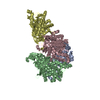

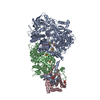


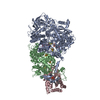
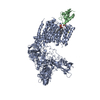
 PDBj
PDBj

















